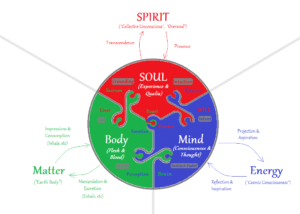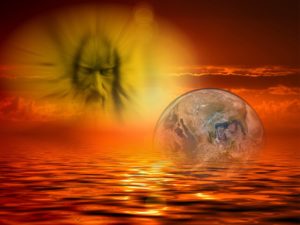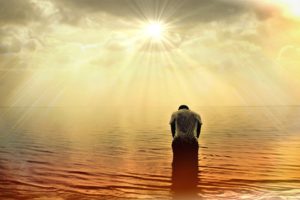What is the Biblical resurrection? Sadly, there is much misinformation on the subject leading to wild claims. To get a glimpse of what the true resurrection is, I am going to use the Old Testament concepts from the story of Cain and Abel, and then link it back to 1 Corinthians chapter 15. This chapter is greatly misunderstood by mainstream religion, so we’ll correct the fallacies and try to get a grip on what Paul meant.
Understanding the Biblical resurrection must come from a greater understanding of ourselves. The story of Cain and Abel fills in some important concepts for us.
The Symbolic Nature of Cain and Abel
Much of the esoteric nature of of the Bible is hard to interpret, but the story of Cain and Abel is relatively simple. The clues aren’t even hidden. They’re blatant! Let’s break it down.
The straightforward version: Adam and Eve conceive twin brothers. Cain comes first, then Abel. Cain is a tiller of the ground. Abel tends sheep. When the time comes, they both bring an offering to the Lord. For no apparent reason (at least not one revealed directly in the text), the Lord rejects Cain’s offering. But God accepts Abel’s offering of sheep. Is the Lord discriminatory against vegetables? Or maybe he just hates brussel sprouts and broccoli?
All joking aside, the key to understanding the deeper spiritual significance of the story is actually in their vocations. Cain was doomed from the beginning. Let’s see why…
Ancient adepts wrote this story to explain the very early stages of the One consciousness expressing itself through human kind. Adam and Eve being expelled from the garden symbolizes spirit expressing itself in duality on the lowest (physical) plane. Cain and Abel are two different paths the soul can take. One path aspires back towards unity with God (Abel), and the other (Cain), being unaware of this path back to unity, or even that there is unity, remains rooted in separateness, illusion, and the “I” feeling that consciousness experiences in duality on the physical plane. In many ways, the story of Cain and Abel represents the first metaphysical struggle between our lower and higher self.
Abel is that beginning aspiration which seeks to establish consciousness in the higher self through love and unity, while Cain is that which is rooted in the lower ego, and is only concerned with “I,” or “me.” As this very early stage of human consciousness, Cain always prevails over Abel.
Cain and the Ground
Cain is a tiller of the ground. The ground is a symbol of the lower nature within the soul. Think of the ground as the lowest point of involution of spirit, or the one consciousness, in physical matter. Cain is the personality and lower mind that fully functions at the beginning of incarnating into physicality.
God could never accept Cain’s offering, because his labor as a tiller of the ground symbolizes humans operating through the lower mind only. Paul tells us the carnal mind is at enmity with God. The carnal mind is not just sensations (physical), it is the entire personality comprised of mental, emotional, and physical consciousness at its lowest point of involution with the human (i.e., the ground).
Sidenote: For someone wanting to see the bigger picture, the line of Cain, metaphorically speaking, represents those living and staying in the lower ego. Adam and Eve’s next line, with Seth, represents mankind who aspires, through stages of consciousness, to transcend the lower ego experience and expands his or her awareness as symbolized in Noah, Abraham, Moses, Joshua, David, Solomon, Elijah, and Christ.
The First Murder was Metaphysical
Of course in the narrative Cain gets very upset. God tells him sin (separation and illusion) is always before him, but if he does well (seeks the higher self through through virtues and love like Abel), he will be accepted. And of course Cain cannot do this. Remember what the Apostle Paul also states:
“Because the mind set on flesh is hostile towards God; for it is not subject to the law of God, nor can it be” (Romans 8:1).
“The mind set on flesh” is the carnal or lower nature. Again, Cain signifies one whose mind is set on flesh because he is a tiller of the ground.
You see! Poor Cain never had a chance! In fact, just understanding all this could make us predict would Cain would do next even if we hadn’t read the story. He kills Abel! The lower ego rejects love, always. Anytime we act from the lower aspect of ourselves, we act out of fear and survival. Keep in mind this isn’t literal. Cain never actually murdered a person. This whole fiasco is symbolic of the lower nature killing that aspect which seeks the higher nature / self. Why? Because it must in the early stages of consciousness evolution. It is always at enmity with God.
What about Abel? The sheep that Abel tends are symbolic of virtues. Christ said his sheep hear his voice. These are ever the virtues that the soul can become rooted in around the Christ nature, drawing the soul closer and closer back to unity with God. But in Cain, the lower nature kills that aspect of our soul which chooses to tend to the (sheep) virtues.
One more important point about Cain as a tiller of the ground: As Gaskell states, the lower nature must be sown and tilled to truly reap fruit. This long process of sowing, tilling, and reaping in the soul is what the soul’s sojourn on earth is all about. The soul that lives in ignorance, will need to be sown, tilled, and reaped over and over (karma and reincarnation) until that ego realizes it’s wretchedness and aspires towards something greater than it’s limited self.
Next, God banished Cain from his presence. Cain is banished to the Land of Nod. Nod represents the land where the personality is in total control of the soul, and is at the mercy of the desire-nature, rooted in total separateness of the true self. The personality is expressed through the physical, mental, and emotional consciousness rooted in this illusory separation. These aspects of us, thoughts, emotions and sensations (all three manifested in the physical temple) always begin the journey away from God’s presence in the land of Nod. At first, no man knows God, and the illusion of separateness through the ego is our Nod experience.
Cain’s Wife a Blatant Clue
Cain even gets a wife in Nod. Again, not a literal woman. The term “wife” is always symbolic of the emotion nature allied with the mind (man). This is what the personality is! This shows the template for the lower nature made up of thought and emotion exhibited through the physical body.
He is sent to the land of “Nod,” which is symbolic of being driven (or separate in illusion) from the presence of the Lord (higher self). Remember, the lower nature is at enmity with God and can never bring an offering (from the flesh) that would ever please God.
When Paul speaks of the carnal mind, or the mind of flesh, he is speaking of the lower nature in its entirety, which again, comprises the personality manifested through thoughts, emotions, and sensations within the physical temple. This is why Cain is allowed to get away with murder and begin a new journey with a mark to protect him. No matter how corrupt the lower nature is, it always has the chance (through many lives), to evolve through the experiences of adversity and suffering. Early humanity spent many incarnations doing this.
Abel doesn’t do much. But his symbolic meaning is the important part. Even in the beginning, the soul has aspirations towards something that is higher and greater than the limited ego rooted in the personality. For much of early humanity, it was just killed by our twin (within us) before it accomplished anything except the faintest of beginnings of a new consciousness experience.
The Template has been Set
Now we can begin to talk about Paul’s concept of resurrection. We understand from earlier Biblical stories (and not just Cain and Abel), that the lower nature, or the “I” feeling we all have, is comprised of a tri-part nature, or temple. Mind = thoughts, emotions, physical temple. All three make up the lower self. This is the grand illusion, and it is a very small and limited manifestation of who you really are.
The Apostle Paul understood this lower nature of man quite well. In fact, at times he seems completely annoyed by it. He states, that which I would do, I don’t. And that which I would not do, I do! It’s like the Abel in him is killed over and over and he admits it in frustration. But no worries. Paul also understands the power of the Christ within us, our hope of Glory, who is able to resurrect this lower self and cause a union of it with the higher self. And it is only the power of Christ manifested in our complete temple that can affect this transformation of the mind.
Yes! Christ is resurrected in a physical body, but it’s your physical body. One that is still alive. Not a body that’s already been literally put in the ground. He’s resurrected in your body! Most humans are past the Nod stage, but you still have to manifest an Abraham within you first that cuts covenant, or an agreement with God the higher self through faith. This is where the real journey begins. Abraham is the father of faith because he is symbolic of the divine nature becoming active in the soul by leaving his former land of the ego and traveling to a land that God will give to his seed. This is the Promised Land, and it is nothing like Nod. In fact, it is not a State of consciousness rooted only in the personality and lower ego, but a State of consciousness that receives the blessings of milk and honey (higher emotions – wisdom). Wisdom of what? Wisdom that comes from the intuition, the true reality, that is not separate from God. It is the spiritual food from above which transcends the human mind and intellect, and it is a remembering of where you came from before your descent (incarnation in matter).
Paul’s Resurrection is Purely Metaphysical
By this point in the article, you’ve already guessed it. Paul’s Resurrection is only metaphysical. The physical body will die. Your personality is fleeting. The labels and memories that make up who you are as the personality in this life, in the earthly vessel, will pass away. But the “who” you think you are now through labels and memory is really but a very tiny and limited aspect of your higher self. Paul knew this fact. He never ever spoke about a resurrection where literal physical bodies (along with all the thoughts and emotions and memories) would be put all back together from the grave. All his writings are spiritual in nature. Paul states flesh and blood cannot inherit the kingdom of God. Paul also taught that Christ must be fully resurrected within the individual which is this great process and the completion of the renewing of the mind of man. Not just a transformation of the lower mind, but a union of lower mind with the spiritual mind and higher self. When Christ is all in all within the individual, the higher spiritual mind and emotions are in unity, being ruled by the higher self or Christ within. This is why Jesus also taught seek ye first the kingdom of God, which is within you. Paul’s vision of Christ on the road to Damascus indicates this realization. Paul speaks of this in Corinthians:
1 Corinthians 15: 3-8
“For I delivered unto you first of all that which I also received; how that Christ died for us according to the scriptures; and that he was buried, and that he arose again the third day according to the scriptures; And that he was seen of cephas, then of the twelve.”
Let’s break down some more symbols here. Cephas, or Peter, signifies the natural man, or the ego. The natural man must first perceive that there is a spiritual truth higher than himself. This is the first step, and it is why Paul writes esoterically, mentioning Cephas first. Cephas is the little rock that God’s kingdom is first built upon.
The twelve are the disciples, which are symbolic of the soul qualities which have completed an initiation into the Christ-soul. Even Jesus went up to Jerusalem at twelve years of age for the feast (Luke 2:42). There are twelve signs of the Zodiac, twelves tribes, twelve disciples, and twelve apostles. All indicate the same. Now let’s continue quoting 1 Corinthians:
“After that he was seen of five hundred brethern at once; of whom the greater part remain unto this present, but some are fallen asleep. After that, he was seen of James, then all the Apostles. And last of all he was seen of me also.”
What 500 signifies is too complicated to go into here, and would take another post about the book of Ezekiel to explain (maybe another day). But James is a symbol for the mind and enlightenment.
According to Gaskell: James is “…the mental edifice of the human being, that is, the mentality or instrument of the mind, which is built up by the soul-qualities through aspiration and enlightenment.”
Are we beginning to see a pattern here? Paul’s revelation of the Christ begins with the natural man, progresses through the soul qualities, goes through the state of James, and then to himself.
Notice how Paul then states Christ was seen of him also. Paul’s statement here indicates that Christ appeared to everyone in the same way. How did Christ appear to Paul? Again, read the road to Damascus. It wasn’t Jesus in a physical body that appeared to him. It was a bright light on the road to Damascus, indicating an experience within consciousness. Paul’s risen Christ is always metaphysical in nature. Paul never speaks of a virgin birth, the miracles of Jesus, his early life, etc. Why? This was not important to Paul. Only the resurrected Christ is, which is the power within you. When Paul mentions Jesus as the son of David, he is still speaking allegorically.
Finally, Paul follows James as the last (and in many ways the greatest) apostle to see the resurrected Christ because Paul is symbolic of the mind being transformed by the Christ. His boasting in the New Testament has nothing to do with being the greatest Apostle. He’s simply the mind which has realized the Christ, and still has to correct the natural man (Peter) through life. Paul gives a sharp rebuke to Peter in Galatians. This rebuke is not between two people. The rebuke is about the natural man (Peter) still wanting to be in charge of the soul rather than the Christ, and getting mixed up from time to time!
Final Thoughts on the Resurrection and what it is that is resurrected
I am going to quote Gaskell on the resurrection:
“A symbol of the rising of the Higher Self from the potential to the actual in the minds of humanity: also the rising of the indwelling or incarnate Self from the lower nature ot the higher at the end of the cycle. In relation to the egos, the resurrection signifies the rising of the cosnciousess from the lower mind to the higher in the causal-body at the cycle’s end…”
For beginners, don’t let the language confuse you. The Christ seed is sown by the word. In the beginning, it is only a potential and has not been actualized yet. But the word is not actually the Bible. The word is Christ itself, this power within you that must germinate to bear fruit. I have a great respect of my Christian heritage, even my first church, because it gave me an appreciation for the allegories meant to awaken something already within me. But I realized after many years that my church leaders were more interested in doctrine and doing “good deeds” to follow Christ. But this is not his message. Good deeds are great, but often have very little to do with the transforming of the mind that Paul spoke of. Doctrine and religion still seek Christ through the personality and lower mind, which although can do much good, it is still not the direct realization of Christ within you. The causal body that Gaskell speaks of is a the body of the spiritual ego (not to be confused with the lower mind and ego). The aspects of the personality are attached to it, and come forth from it, but the higher mind, the Christ mind, is established in the causal body, and is not dissolved with death like the personality. The resurrection symbolizes the raising of this lower mind to come into union with the higher mind at some point in human consciousness. Every human life has the potential to express Christ consciousness through the physical body. Those who actualize it are those sheep that hear and follow Christ’s voice – the wisdom gleaned from above by seeking the inner kingdom within each individual, and the higher virtues received through the wisdom-love nature that the higher self contains. More of this to come in future posts.
So what is the resurrection? Let’s simplify it like this: the infinite, limitless POTENTIAL of the self cannot express itself (become actualized) in the physical temple, unless…
The self transcends the mind, beyond the physical, emotional, and thinking machine that it is, while still in the physical temple. When this Transcendence takes place, this awakening, this enlightenment, this realization of itself, then the “I-ness” of the self is retained within the physical temple, while on earth, and the self is thus resurrected. And the union, the Divine marriage, of the lower and higher self is consummated. This is the immortality spoken about in the Bible. This immortality does not mean of the physical body, but of bringing awareness of the self, through direct realization, into death, where the individual remains aware and does not fall alseep (go into complete unconsciousness until the next birth).
Blessings.










